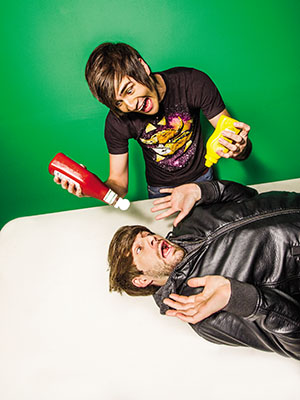
Stars of 'Smosh' Are the New Web Celebs
The stars of Smosh are a new breed of web celebrity who is totally fine sticking to the internet
Ian Hecox and Anthony Padilla are huge stars. As their business partner puts it, “Girls want to date them, and young men want to be them.” The 25-year-olds have a weekly comedy sketch show that attracts 3.5 million viewers. A typical sketch: The merits of having a Pikachu for a pet. On the plus side, he can make toast in an instant. Unfortunately, he also destroys the TV when he tries to change the channel. Their catchphrase is “Shut up”.
Haven’t heard of Hecox and Padilla? If you’re not a teenage boy, don’t feel too bad. They are a new, purely digital breed of star. With 6.9 million subscribers, their channel, Smosh, is among the most subscribed-to YouTube channels.
That used to be a golden ticket to Hollywood, where agents and producers are salivating at the chance to stick a popular, good-looking duo with millions of fans on TV. The most successful pilgrim on this path is Fred, he of the high-pitched voice. Lucas Cruikshank parlayed his series of ear-grating videos into two suc- cessful Fred movies and a TV series on Nickelodeon. He now has his first non-Fred role on Marvin Marvin, a sort of modern-day Mork & Mindy.
Hecox and Padilla have a different vision of success. Instead of making the leap to television, they are building Smosh into an online media company. With Alloy Digital, they expanded Smosh into five channels that in December attracted 157 million views.
And they’re making real money, too. We estimate Smosh brought in $10 million in revenue in the last 12 months. Half of that comes from ad sharing with YouTube. The other half comes from ads on Smosh.com, merchandise sales and iTunes downloads of a Smosh app and Hecox and Padilla’s comedy songs.
“We’ve seen other internet people go to TV,” says Padilla. “And it’s bad because they take two months off to make a pilot and their viewers have forgotten about them when they come back.” Adds Hecox: “It boils down to this. We are not leaving the internet.”
“I think they can be as big, if not bigger, than mainstream stars,” says Brent Weinstein, head of digital media at United Talent Agency. That’s high praise for guys who got their start recording themselves lip-synching TV theme songs in Padilla’s bedroom in Sacramento, California, seven years ago. Under-employed and barely attending community college, they funded their hobby by selling T-shirts to their small fan base.
Hecox and Padilla’s timing was perfect, though, because that same year YouTube exploded onto the scene. There weren’t many people doing weekly programming on the website, and when the pair uploaded a lip-synched parody of the Pokémon theme song, it landed on the YouTube front page (reserved for the most popular videos) for several weeks. The video attracted 24 million views.
It also caught the eye of Barry Blumberg, who had just left his job as president of Disney’s television animation. “Every teen boy has acted like those guys did in their first videos,” says Blumberg. “They created a very strong connection.”
Blumberg signed on to help Hecox and Padilla develop their website into a real business. He forged a deal with YouTube that made Smosh one of the first 10 channels to earn money from the website—a guaranteed $9,000 per month if they let YouTube put some display advertising on their videos.
Afraid the ads would scare away viewers, Hecox and Padilla secretly turned off the ad function, so even though they were attracting millions of viewers, none of the hits was counting toward their ad revenue. When Blumberg persuaded them to turn the ad function back on (the benefits of having a grown-up on board) their ad-sharing revenue soared well past the $9,000 monthly guarantee.
In 2009 they expanded the stand-alone site Smosh.com to include original blogs, like a slide show of cats with afros. Alloy came on board to help Smosh sell ads. “We were looking for content that we could help build into a franchise,” says Alloy Chief Executive Matt Diamond. “We felt they were bigger than a few guys putting up videos every week.”
In 2011 Alloy bought Smosh for an undisclosed sum. The sale gave Hecox and Padilla the money to build Smosh into a media empire. The brand now has five channels, including Shut Up Cartoons, a YouTube-funded channel that features 16 cartoon series. Hecox and Padilla don’t work on the shows directly, but they are all Smosh-approved. The channel has attracted only 754,000 subscribers, but YouTube is likely to renew it for a second year.
They’ve had better luck with Smosh Games, which launched in September. The channel features a crew of 20-somethings playing and reviewing videogames. The channel is signing up 8,000 new subscribers a day.
Growth for Smosh will come in the form of more channels, higher payments for every thousand views, and opportunities on connected TVs. There could be games and more apps, anything that keeps viewers connected to the Smosh brand. In the meantime, tune in for talk about videogames, TV shows and plenty of references you’re too old to understand.
(This story appears in the 22 February, 2013 issue of Forbes India. To visit our Archives, click here.)















